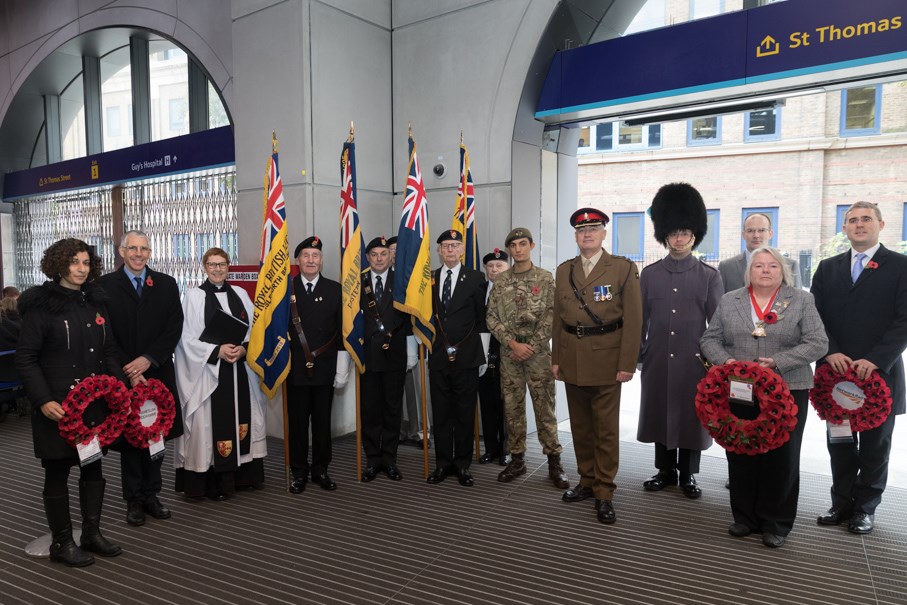Monday 12 Nov 2018
Network Rail South East remembers the fallen
- Region & Route:
- | Southern
Network Rail South East marked the 100th anniversary of the end of the First World War with a series of remembrance events at stations as respects were paid to the railway workers and all those who served, sacrificed and changed our world.
On Thursday 8 November, there was a landmark moment at St Pancras International as the station unveiled its first ever permanent war memorial, while on Friday 9 November London Bridge’s war memorial was re-dedicated for the first time since moving locations during the rebuild of the station. On Armistice Day itself, Network Rail proudly hosted a ceremony at London Victoria station to commemorate the thousands of railway staff who played a part in both world wars.
Ian Hanson, stations director for Network Rail South East, said: “Railway colleagues made a vital contribution to the war effort. Our ceremonies at St Pancras, London Bridge and London Victoria paid tribute to these efforts, from our railway colleagues who signed up for active duty, to those who helped the railway move huge amounts of people and equipment between the UK and France during both world wars.”
St Pancras International’s new memorial was created by artist and writer Fabian Peake, to commemorate all those associated with the station who lost their lives during the two World Wars.
This year, on its 150th anniversary and the centenary of the end of World War One, St Pancras International is dedicating the four-metre high memorial as a poignant reminder of the fundamental role the railways played during the wars, reflecting on the lives of those who fought and died serving in the armed forces, as well as civilians.
The memorial sits on the station’s Grand Terrace, close to the location of bomb damage from two prominent air raids in 1918 and 1941 - the first of which claimed the greatest number of casualties suffered in any air raid on a London station during the First World War.
Going forward, the artwork will also mark the location of the annual Armistice memorial.
On Friday, 9 November, London Bridge station’s 1920s bronze war memorial was re-dedicated for the first time since moving locations during the rebuild of London Bridge station. The ceremony was officiated by the Canon Precentor of Southwark Cathedral and supported by standard bearers from the Royal British Legion.
The London Bridge war memorial was dedicated in its original location on its installation in 1921, by the then Canon Precentor of Southwark Cathedral, John Bernard Haldane. While the station was being rebuilt as part of the Thameslink Programme, the memorial was preserved and restored, before being reinstalled in a carefully selected location.
Wreaths were laid at London Bridge on behalf of Network Rail, the Thameslink Programme, the London Bridge station team, Southwark Council and the local community.
On Armistice Day itself, Network Rail proudly hosted a remembrance ceremony at Victoria station. Around 150 guests were present as the Vicar of St Peter’s church led prayers and tributes for those who bravely defended the country in two world wars, before a poignant silence as the Last Post rang out around the station (see video attached).
Victoria Station Remembers the Fallen
The two memorials at Victoria commemorate the staff of the London, Brighton and South Coast Railway and those of the South Eastern and Chatham Railway. More than 10,000 men from both companies signed up for service in 1914, with more than 1,000 never returning to the railway.
Notes to Editors
Notes to Editors
The railway played a vital role during WWI. When Britain declared war on Germany in 1914, trains efficiently moved huge numbers of troops and equipment between the Home Front and France. Trains also transported rations, water and coal across Britain and continental Europe in a way not previously possible during conflict.
Britain declared war on 4 August 1914 and by the end of the month, the railway had transported almost 120,000 servicemen to Southampton, where they would board boats to France. The first train carrying members of the original expeditionary force left Waterloo station on the morning of Sunday 10 August, arriving into Southampton station at 8.15am. Over the next three weeks, a train full of troops would reach the docks every 12 minutes, 14-hours a day.
In 1914, the country had 23,000 miles of rail track and 4,000 stations. Passenger numbers had reached more than 1.5 million and the railway had become one of Britain’s biggest employers with more than 700,000 workers. Of these, more than 100,000 enlisted when war broke out. By the end of the war, 20,000 railway staff had tragically lost their lives. The railway remembers them in memorials across the country.
Contact information
Passengers / community members
Network Rail national helpline
03457 11 41 41
Latest travel advice
Please visit National Rail Enquiries
Journalists
Network Rail press office - Carl Ferguson
Media and Communications Executive
Network Rail
02033577969
07808244752
Carl.Ferguson@networkrail.co.uk
About Network Rail
We own, operate and develop Britain's railway infrastructure; that's 20,000 miles of track, 30,000 bridges, tunnels and viaducts and the thousands of signals, level crossings and stations. We run 20 of the UK's largest stations while all the others, over 2,500, are run by the country's train operating companies.
Usually, there are almost five million journeys made in the UK and over 600 freight trains run on the network. People depend on Britain's railway for their daily commute, to visit friends and loved ones and to get them home safe every day. Our role is to deliver a safe and reliable railway, so we carefully manage and deliver thousands of projects every year that form part of the multi-billion pound Railway Upgrade Plan, to grow and expand the nation's railway network to respond to the tremendous growth and demand the railway has experienced - a doubling of passenger journeys over the past 20 years.
Follow us on Twitter: @networkrail
Visit our online newsroom: www.networkrailmediacentre.co.uk

